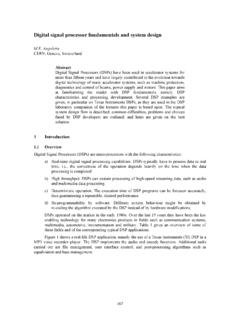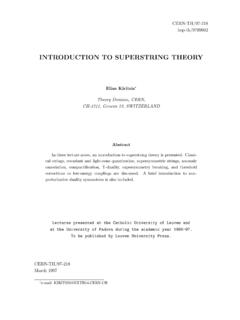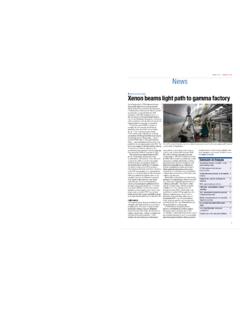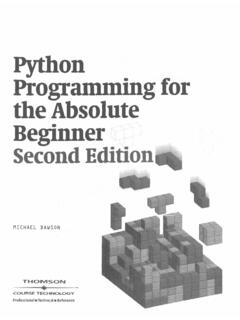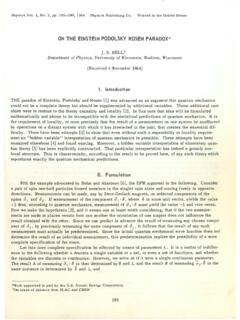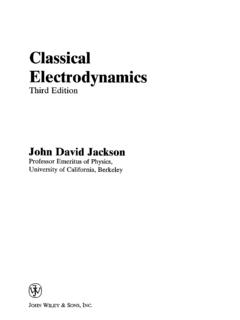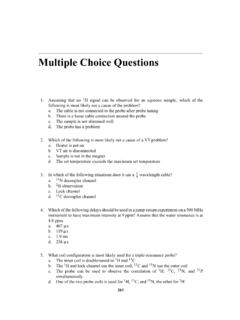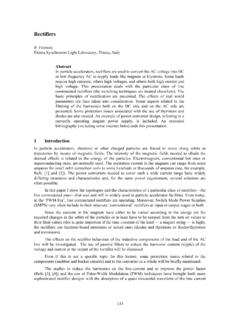Transcription of RF engineering basic concepts: Sparameters
1 RF engineering basic concepts: S- parameters F. Caspers CERN, Geneva, Switzerland Abstract The concept of describing RF circuits in terms of waves is discussed and the S-matrix and related matrices are defined. The signal flow graph (SFG) is introduced as a graphical means to visualize how waves propagate in an RF. network. The properties of the most relevant passive RF devices (hybrids, couplers, non-reciprocal elements, etc.) are delineated and the corresponding S- parameters are given. For microwave integrated circuits (MICs) planar transmission lines such as the microstrip line have become very important.
2 1 S- parameters The abbreviation S has been derived from the word scattering . For high frequencies, it is convenient to describe a given network in terms of waves rather than voltages or currents. This permits an easier definition of reference planes. For practical reasons, the description in terms of in- and outgoing waves has been introduced. Now, a 4-pole network becomes a 2-port and a 2n-pole becomes an n- port. In the case of an odd pole number ( , 3-pole), a common reference point may be chosen, attributing one pole equally to two ports. Then a 3-pole is converted into a (3+1) pole corresponding to a 2-port.
3 As a general conversion rule, for an odd pole number one more pole is added. I1 I2. Fig. 1: Example for a 2-port network: a series impedance Z. Let us start by considering a simple 2-port network consisting of a single impedance Z. connected in series (Fig. 1). The generator and load impedances are ZG and ZL, respectively. If Z = 0. and ZL = ZG (for real ZG) we have a matched load, , maximum available power goes into the load and U1 = U2 = U0/2. Note that all the voltages and currents are peak values. The lines connecting the different elements are supposed to have zero electrical length. Connections with a finite electrical length are drawn as double lines or as heavy lines.
4 Now we would like to relate U0, U1 and U2 to a and b. 67. F. C ASPERS. Definition of power waves'. The waves going towards the n-port are a = (a1, a2, .., an), the waves travelling away from the n-port are b = (b1, b2, .., bn). By definition currents going into the n-port are counted positively and currents flowing out of the n-port negatively. The wave a1 going into the n-port at port 1 is derived from the voltage wave going into a matched load. normalized to Z0. Z0 is in general an arbitrary reference impedance, but usually the characteristic In order to make the definitions consistent with the conservation of energy, the voltage is impedance of a line ( , Z0 = 50 ) is used and very often ZG = ZL = Z0.
5 In the following we assume Z0 to be real. The definitions of the waves a1 and b1 are incident voltage wave ( port 1). = = =. U0 U1inc a1. 2 Z0 Z0 Z0. reflected voltage wave ( port 1). ( ). =b1 =. U1refl Z0 Z0. Note that a and b have the dimension power [1]. The power travelling towards port 1, P1inc, is simply the available power from the source, while the power coming out of port 1, P1refl, is given by the reflected voltage wave. 2 2. = = =. U1inc I1inc inc 1 2. P1 a1 Z0. 2 2Z0 2. ( ). 2. = = =. 1 2 U1refl I1refl refl P1 b1 Z0. 2 2 Z0 2. Note the factor 2 in the denominator, which comes from the definition of the voltages and currents as peak values ( European definition').
6 In the US definition' effective values are used and the factor 2 is not present, so for power calculations it is important to check how the voltages are defined. For most applications, this difference does not play a role since ratios of waves are used. In the case of a mismatched load ZL there will be some power reflected towards (!) the 2-port from ZL, leading to some incident power at port 2. P2inc =. 1 2. a2 . ( ). 2. There is also the outgoing wave of port 2 which may be considered as the superimposition of a wave that has gone through the 2-port from the generator and a reflected part from the mismatched load.
7 = =. inc We have defined a1 U 0 / (2 Z 0 ) U inc / Z 0 with the incident voltage wave U . In analogy to that we can also quote for the power wave a1 = I inc Z 0 with the incident current wave Iinc. We obtain the general definition of the waves ai travelling into and bi travelling out of an n-port: 68. RF engineering basic CONCEPTS : S- parameters . Ui + Ii Z0. ai =. 2 Z0. Ui Ii Z0. bi =. ( ). 2 Z0. Solving these two equations, Ui and Ii can be obtained for a given ai and bi as Ui = Z 0 ( ai + bi ) = U iinc + U irefl ( ai =. bi ). ( ). =. 1 U irefl Ii . Z0 Z0. For a harmonic excitation u(t) = Re{U e j t } the power going into port i is given by Pi =.
8 1. { }. Re U i I i*. {( ) ( )}. 2. = Re ai a*i bi bi* + a*i bi ai bi*. 1. Pi ( ). ( ). 2. = ai a*i bi bi*. 1. Pi 2. The term (ai*bi aibi*) is a purely imaginary number and vanishes when the real part is taken. The S-matrix The relation between ai and bi (i = ) can be written as a system of n linear equations (ai being the independent variable, bi the dependent variable). b1 = S11a1 + S12 a2. b2 = S21a1 + S22 a2. ( ). or, in matrix formulation b=Sa ( ). The physical meaning of S11 is the input reflection coefficient with the output of the network terminated by a matched load (a2 = 0). S21 is the forward transmission (from port 1 to port 2), S12 the reverse transmission (from port 2 to port 1) and S22 the output reflection coefficient.
9 When measuring the S-parameter of an n-port, all n ports must be terminated by a matched load (not necessarily equal value for all ports), including the port connected to the generator (matched generator). Using Eqs. ( ) and ( ) we find the reflection coefficient of a single impedance ZL connected ( Z / Z0 ) 1. to a generator of source impedance Z0 (Fig. 1, case ZG = Z0 and Z = 0): U I Z Z Z0. S11 = 1 = 1 1 0 = L = = L. ( Z L / Z0 ) + 1. b a1 a = 0 U1 + I1Z 0 Z L + Z 0. ( ). 2. which is the familiar formula for the reflection coefficient (sometimes also denoted as ). 69. F. C ASPERS. Let us now determine the S- parameters of the impedance Z in Fig.
10 1, assuming again ZG = ZL = Z0. From the definition of S11 we have b1 U 1 I 1 Z 0. S 11 = =. a1 U 1 + I 1 Z 0. Z0 + Z. U1 = U 0 , U2 = U0 , I1 = = I 2. Z0 U0. 2Z 0 + Z 2Z 0 + Z 2Z 0 + Z. S 11 =. Z. 2Z 0 + Z ( ). and in a similar fashion we get b2 U 2 I 2 Z 0. S= = =. 2Z0. a1 U1 + I1Z 0 2 Z 0 + Z. 21 . ( ). Due to the symmetry of the element S22 = S22 and S12 = S21. Please note that for this case we obtain S11 + S21 = 1. The full S-matrix of the element is then Z0 + Z . 2Z + Z 2Z0 + Z . Z. S= . Z0 + Z . 0. ( ). 2Z + Z 2 Z 0 + Z . Z. 0. The transfer matrix The S-matrix introduced in the previous section is a very convenient way to describe an n-port in terms of waves.
